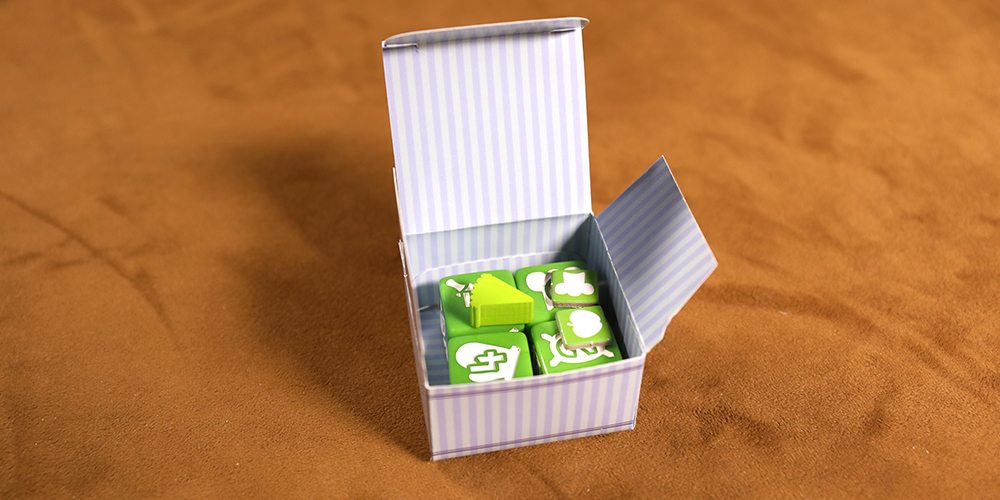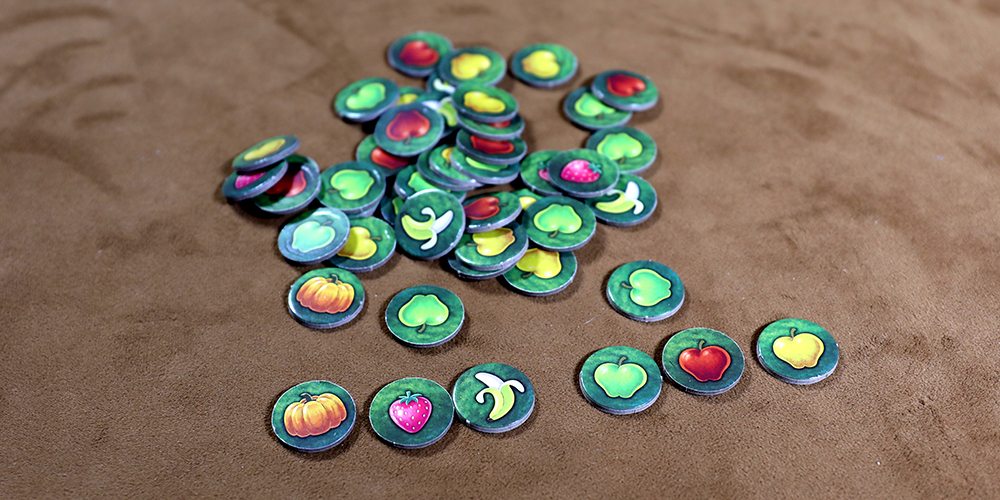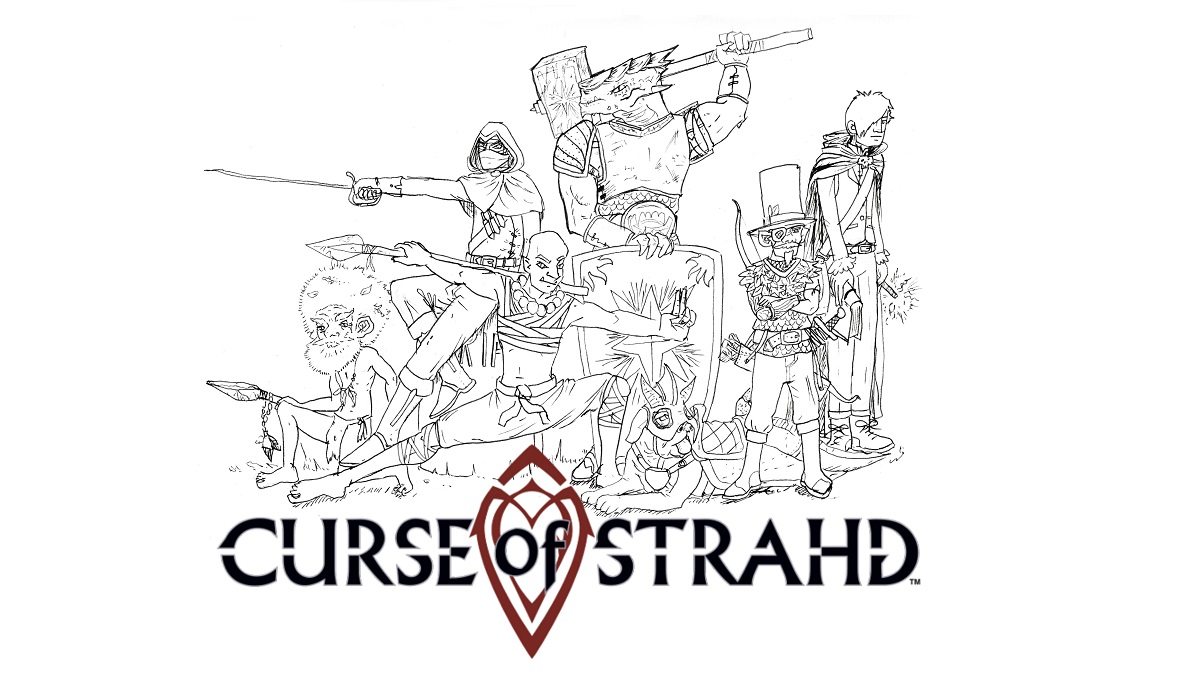What is Pie Town?
Pie Town is a family-friendly worker placement game from Renegade Game Studios that is for 2-4 players, aged 14 and up, that plays in 60-90 minutes.
Pie Town Components
The box is surprisingly full (much like me after getting my hands on some pie). It’s full enough that after first punching the game, the lid doesn’t really fit back on very well. However, there is a solution and I’ll get to that after describing the components.
In the box, you’ll find:
- 1 Score board
- 1 Market board
- 1 Orchard board
- 4 Store boards
- 54 Common ingredient tokens
- 27 Rare ingredient tokens
- 48 Pie tokens (12 ea in 4 colors)
- 16 Worker dice (4 ea in 4 colors)
- 12 Upgrade tokens (3 ea in 4 colors)
- 4 Score markers
- 4 Dry erase cards with markers
- 4 Recipe boxes
- 12 50-point tokens
- 1 Start player marker
- 1 Round marker
- 1 Cloth bag
As you might expect from Renegade, all the components are great. The boards are all thick cardboard and wonderfully illustrated. The artwork is very cartoony, which might give a false sense of what’s involved in a game. Belying the bright colors and picture board illustrations, Pie Town is an involved game with lots of options and a decent amount of strategy.

The Score board is made up to look a bit like a fair or festival in a park. The Market board looks like the interior of a pie store where pies line up to be sold. The Orchard board is a group of nine trees, the branches between them delineated by a hex space for each tree and eight spots with areas to place pie ingredients. Even though it’s a number of trees, the die cut of the Orchard board still manages to look like a single tree. It’s a neat effect. The store boards are broken into a half dozen areas, where you can assign workers. There is a storage room, an office, a kitchen, and others.

The ingredients are broken into two types, common and rare, with three ingredients in each group. All tokens are double-sided and about the size of a US dime. The background on all is green and on each of the common ingredients is an apple, in yellow, green, or red. Golden Delicious, Granny Smith, or Jonathans, I guess. On the rare ingredients, there is either a strawberry, banana, or pumpkin.
It doesn’t matter what kind of pie you bake, as for the red player (or purple, yellow, or green), all your Pie tokens look the same, whether it’s pumpkin or apple or anything else. The same goes for the upgrade tokens and the Worker dice and Score markers. The upgrade tokens are pretty small and have an icon to help you locate their position on the Store boards. The worker dice are d6 and numbered 1 through 6, but have been augmented with baking related icons. The score markers are shaped like wedges of pie.
The 50-point tokens are meant to look like prize ribbons and the dry erase cards are single sided with a row of common and rare ingredients and a space for a player’s name. This is done three times and the card will be used to try to identify your opponents’ secret recipe. More on that in the rules. The recipe boxes are a small treat. They are teeny boxes that open from the top and provide a place for tokens to be placed as part of that top secret recipe.

The cloth bag is a branded cloth bag. But the really great parts are the first player marker, a chef’s toque, and the round marker, which is a rolling pin. Fantastic! All of the pieces really fit the theme and get you excited to begin playing and making pies. (Well, almost all the pieces. A cloth bag is always just going to be a cloth bag. You can’t do much about that.) But it’s still pretty impressive and pretty and suggestive of fun.
As I mentioned, after your first game, you might have a tough time packing it all back in the box. However, there is a great solution we figured out after our first game. Simply take the dice, upgrade tokens, and player markers for each player and place them in one of the Secret Recipe boxes. It’s perfect and the lid sits nicely and squarely with that minor adjustment. (Thanks for the suggestion, Harrison!)

How do you play Pie Town?
Setup
You might think you need a lot of space to play Pie Town, with its many boards and components. I did, at first. But you don’t. The boards are all smaller in size. The Market and Score board are each both about the size of a sheet of notebook paper and you can set them side by side on most tables. You can set both at one end of the table and have one or two players be responsible for moving tokens around on those boards. The Orchard board should be placed at the center of the table because players will likely be visiting there the most.
Each player gets a store board and then the Worker dice, Upgrade tokens, Pie tokens, and scoring token of their color. Additionally, they get a recipe box, Dry-erase cards and a marker, and one of each common ingredient, which can be placed in the Storage area of your store.
Upgrade markers should be placed on the Storage area, on the box marked 8, meaning you may store up to 8 ingredients, in the kitchen, on the 1, meaning the number of victory points you get for each pie baked. The last upgrade marker is place in the Bake area of your store, which will regulate the number of Workers you can send to go Bake. Two Worker dice are placed in the Break Room, one is turned to 2 and the other to 3. All players should place their scoring marker on 0 on the scoring track and place the rolling pin on the first round.
You’re almost ready to go!

All pies are made from three ingredients and, before play begins, you must create your own secret recipe. All players secretly come up with a secret recipe for a pie that includes two common ingredients and one rare ingredient (note: all ingredients must be different). When you’ve figured out your recipe, place the ingredient tokens in your recipe box and seal the box so no one can see.
Place all remaining ingredients in the cloth bag and then randomly place ingredients on the Orchard board on the designated spaces. There are hexes marked for a three-player game and a four-player game–don’t place more ingredients than the number of players in your game.
Gameplay
Pie Town is a worker placement game, so nearly all that you’ll be doing is sending your workers to locations on the boards and having them complete tasks that score you points or advance your cause. Play begins with the first player, who sends a single worker to a location, followed by the next player, and so on, until all players have sent out all workers. Once all workers have been placed, they are retrieved and placed back in the Break room, ending the current round.

On a player’s turn, they have a wide range of activities to complete. The first thing they can do is visit the Orchard to collect ingredients. By placing a Worker die on one of the designated spots, a player can take ingredients up to the value of the die face. That is, if the die shows 3, they may take 3 ingredients to put in their Storage area. These ingredients may be taken from any hex that is adjacent to where their die was placed.
Placement also introduces a new concept to the game. When a Worker is retrieved from a board, players need to look to the lower right of the area that their Worker is assigned. In almost every area you can send a Worker, there is an icon of a die with either a negative number, in red, or a positive number, in green. At the conclusion of the round, when the Workers go back to the Break room, you will add or subtract the number in that icon to your Worker placed in that area. This allows Workers to become more productive as the game moves along, but it also prohibits a player from taking an action if they don’t have the ability to fulfill the cost at the end of the round. (You can’t send a Worker with a value of 1 to a spot that requires you to subtract one at the end of the round.)
The next thing you can do is Bake. By baking, you can bake a number of pies up to the number on your Worker. All pies fit into one of three categories regarding ingredients: Common-Common-Common, Common-Common-Rare, or Common-Rare-Rare. Even your secret recipe fits these categories as Common-Common-Rare.

As players bake pies, you will need to pay attention to the types of pies they bake and attempt to discern what their secret ingredients are. However, when players bake pies, they needn’t define which ingredients are for which pie they bake. If you are baking three pies, you can put all the ingredients in a single group and, as long as you meet the criteria for each pie you bake, you are safe. This allows you to hide Secret Recipes among regular pies.
A player can guess your Secret Recipe. They do this by taking the Bake action and showing you ingredients they think are yours. If they are right, they can bake your Secret Recipe as well as their own. If they are wrong, the ingredients are returned to the bag. (You can still bake other pies that round.) If correct, not only does this score them Bake points, but it really pays off at the Market. Baked pies are placed on the counters of the Market and you are limited to a quantity for each type that is tied to the number of players in the game.
When selling pies at Market (another task for a Worker), you can either sell all pies in a category counter or all the pies on the front counter (one from each available category). Common-Common-Common are worth 2 points, Common-Common-Rare are worth 3 points, Common-Rare-Rare are worth 4 points, and Secret Recipes are worth 7 points each. Additionally, you score the value of the die face of the Worker you sent. When returning from the Market you get to draw two ingredients.

A player who goes to the Pie Convention, that festival in the center of the Scoring board, can either assign a new starting player or change one ingredient in their secret recipe. A player who sends a Worker to Upgrade may expand their Storage, improve their Kitchen (and points per pie baked), or expand their Bake ability to two Workers. Finally, a Worker may be used to Hire another Worker. The new Worker comes in with a value of one.
These are all the actions a Worker can take, but there’s another key mechanic to consider before sending your Workers out to take actions. In either the Market or the Orchard, Workers can be spied on. What this means is, if I send a Worker with a value of 4 to the Orchard and collect 4 ingredients, a subsequent player can place a higher die on top of mine. For each number higher than my die, that player, the one spying on me, can see an ingredient in my Special Recipe box. So if they sent a 6, they can look at two random ingredients. The worst thing is I don’t get to know which two they looked at! That player may then gather Ingredients at the Orchard or sell pies at the Market, like a normal turn.
Play continues like this for nine rounds. On the tenth round a Final Bake Off occurs. Players pull ingredients from the bag and present what they think are the Secret recipes of the opposing players. You get points for right answers and even partials, but negative points if you don’t get any right. You can choose not to participate.
Lastly, any unsold pies receive a single victory point each. All points are tallied and most points win!

Should You Play Pie Town
Let’s face it, pie is good. And there has been a severe shortage of decent pie-themed board games in recent years, so Pie Town is a welcome addition to store shelves. Mmmm, pie. Here’s why it should find a place at your table.
The game has a healthy dose of strategy and fits nicely into the middleweight class of Euro-style games. When it comes to worker placement, I think there are games that work well for families and those that don’t. Some that are a bit more cutthroat, like Keyflower, have strategies or options that, if someone preempts your move, your whole game can be ruined. I suppose that may work for some families, but competitive gaming is not what you typically think of in that regard. Pie Town, on the other hand, is perfect for families looking for something a little meatier with a friendly vibe. There is plenty to do and lots of ways to win, so tears will not be shed when everyone before you hits the Orchard first. Gameplay moves quickly and we have always beaten the suggested 60-90 minute time.

My family enjoys worker placements and my other game groups love them, so this was an instant hit. We really liked the way workers’ abilities changed with the number of actions that could be performed. At the conclusions of our first few games, I was left with the feeling that I hadn’t had enough turns to do everything I wanted to do. I think this is a good sign and one that will keep getting Pie Town to my table–it’s the feeling I remember having when I first played Viticulture, one of my favorite worker placements.
The other thing that I think Pie Town has in its favor is that I can see it has high replay value. The first time we played, one player threw caution to the wind and didn’t care if anyone knew his secret recipe. He just kept baking those pies and ran away with a win. It took the rest of us a bit to catch on and we weren’t able to stop him by the time we figured out what he was doing. Subsequent games allowed us to arrest that strategy, but other avenues appeared. Being protective of your secret recipe does require some subterfuge and it’s fun and, despite what I said about Pie Town being less cutthroat than some worker placements, things can become pretty challenging if you let them. Anytime there is a scarcity of resources or actions, it has the potential to be tough. Fortunately, I feel like even if you allow your game to turn down that path that there are going to be strategies for getting around those pitfalls and everyone still having a great time.
It’s a neat game and if I had to find complaint with it, I would have to say it is probably in the final Secret Recipe reveal in the Final Bake Off. For us–and our experience surely might be different from others’–that final reveal and guesswork has never affected the outcome of the game. It’s okay and it’s fun to see who figured out the most, but, for us, it’s not the big TA-DAA moment that I think it’s meant to be. No matter, the rest of it is really fun.
We also appreciated that, unlike intro worker placements like Stone Age or Lords of Waterdeep, there is more strategy to Pie Town, which helped us stay engaged and means we’ll likely be getting it out for a long time to come. The art is great, the play is fun, and we absolutely adored how much thought went into all the components and gameplay to make sure everything was on theme. If you’ve been looking for a worker placement game that’s great for families, Pie Town really satisfies that craving.
Pie Town hits shelves on Wednesday this week and retails for $45.00.

Click here to see all our tabletop game reviews.
If you’d like to stay up-to-date with all of our tabletop gaming coverage, please copy this link and add it to your RSS reader.
Disclosure: GeekDad received a copy of this game for review purposes.






